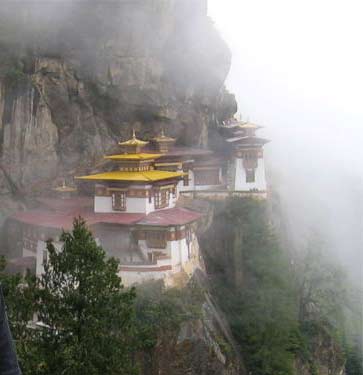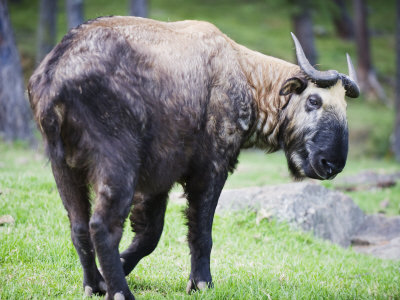Back in June, our friend Bill invited people to his house to see a slide presentation on his trip to
Bhutan. I prepared this blogpost then, but never published it till now.
He hiked there this April, on his own (because the other two people on the trek dropped out on Day 2) for two weeks, with a team of Bhutan guides, only one of whom spoke any English. Most of
the expedition, arranged through
Blue Poppy was on foot, though they rode mules occasionally. Bill learned some useful phrases in
Dzongkha, and even learned a song in that language, which he sang to us!
The Canadians landed at
Paro, on a flight from Bangkok that stopped at a small airport in India on the way, and from Paro they drove uphill for hours in a rattly jeep, to the start of their trek. Everyone has heard of
Shangri-La, the fictional Utopia of the Himalayas, but what is not so commonly known is that "La" means a pass through the mountains. The altitude is so high that it is essential to know where the passes are. The Himalayas make Bhutan virtually inaccessible from the north and dense jungle makes it inaccessible from the south, so it's a self-contained country. Forests of toxic rhododendrons deter exploration; even the local people cannot find a way through them. In the summer the rivers flood and wash away the rickety bridges. Winter is obviously impossible for travelling. In autumn early snow is a great danger, so the only relatively safe time to see the wilds of Bhutan is in the spring, when Bill was there.
After the first night, as mentioned above, his Canadian companions fell prey to
altitude sickness to such an extent that they had to turn back and go home. Camps on the trek allow one yellow tent for the westerners and another, less well appointed one for the guides. Bill felt lonely on his own in the yellow tent when his friends had left, so insisted on joining the guides in theirs. They squatted on the ground to cook, serve and eat. Bill missed access to beer and chocolate, he said. At night he found it hard to breathe, feeling as if he was suffocating, so kept suffering from insomnia.
The mountains, usually best seen in the mornings, were superb. The highest one in Bhutan,
Gangkhar Puensum, 7,570 metres, has never yet been scaled, partly because the "climbing of mountains in Bhutan higher than 6,000 metres has been prohibited out of respect for local spiritual beliefs". There's a different attitude to tourism and mountaineering here than in Nepal. The guides cost far more, work for a fairer price (it costs $250 a day to trek over the passes) and so can support their families from their wages. 30% of the country's land is a conservation area. It has to be, to a large extent. Bill took a picture of
wild takin at close quarters, about the size of a small bison.
The long trek ended at a village that had hot springs and communal bathing in huts. He talked of a "mud field" and imagined the women's three day hike up and down a muddy trail when their babies due, and then returning a month later carrying the babies on their backs.
 |
| Tiger's Nest Monastery (Wikipedia) |
The term "
Gross National Happiness" was coined by the Fourth King of Bhutan, His Majesty Jigme Singye Wangchuck, to analyse the demographics and assess the wellbeing of his people, who mostly still wear traditional clothes (
gho and
kira); only jeans are now creeping in, too. Most Bhutan people are yak herders, who enjoy
archery contests. They drink butter tea and chew
betel leaves as a stimulant, leaving a red residue on their lips and teeth. It's probably addictive. The girls are shy, though at a certain age, boys come to them on night visits, climbing through open windows and finding the girl on her sleeping mat midst of family. There are jokes about finding the mother by mistake, but usually this practice establishes the young people as a married couple. Bill said he saw
phallic symbols everywhere, as well as the prayer flags and prayer wheels. He showed us pictures of these, but the temples for prayer are considered sacred, where photography is not allowed.
A giant buddha sits on the hillside overlooking the Thimphu valley, and Buddhist monasteries such as the
Tiger's Nest near Paro are perched on sheer cliffs.




No comments:
Post a Comment